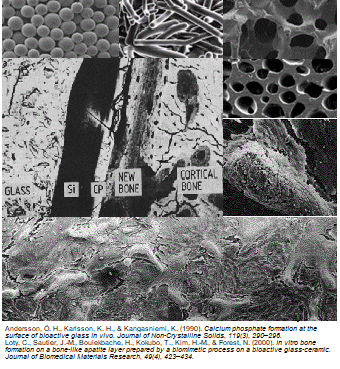BIOACTIVE GLASSES AND GENE ACTIVITION

Controlled rates of dissolution of the glass provide the critical concentration of the biologically active ions to the cells via the interfacial solution. The families of genes that are upregulated and/or activated are shown in Table below. The upregulated genes encode nuclear transcription factors and potent growth factors, especially IGFII, along with IGF-binding proteins and proteases that cleave IGF-II from their binding proteins. The growth factors are present in a biologically active state, as confirmed by analysis of the upregulation of IGF-II mRNA with quantitative real-time PCR. Similar bioactive induction of the transcription of extracellular matrix components and their secretion and self-organization into a mineralized matrix is responsible for the rapid formation and growth of bone nodules and differentiation of the mature osteocyte phenotype.
| No | Families of Genes in Human Osteoblasts Activated or Up-Regulated by Ionic Dissolution Products of Bioactive Glasses |
| 1 | Transcription Factors and Cell Cycle Regulators |
| 2 | DNA Synthesis, Repair and Recombination |
| 3 | Apoptosis Regulators |
| 4 | Growth Factors and Cytokines |
| 5 | Cell Surface Antigens and Receptors |
| 6 | Signal Transduction Molecules |
| 7 | Extracellular Matrix Compounds |
–
REFERENCE: B. D. Ratner, A. S. Hoffman, F. J. Schoen, and J. E. Lemons, “Biomaterials science: an introduction to materials in medicine”, Elsevier, ISBN: 978-0-12-374626-9, 2004.



